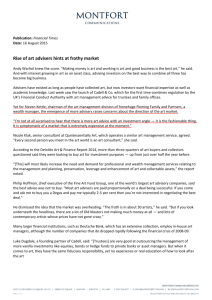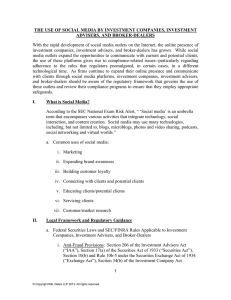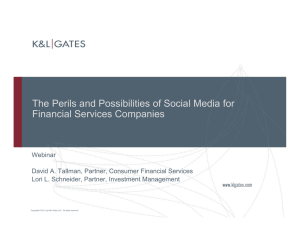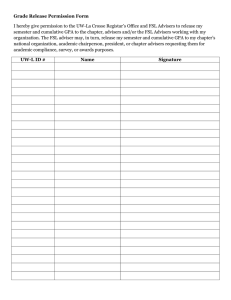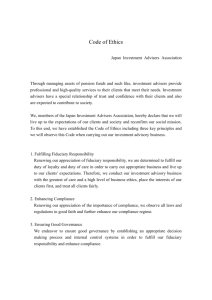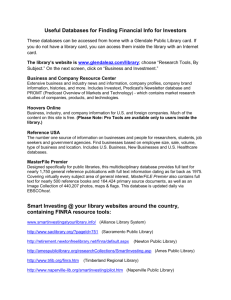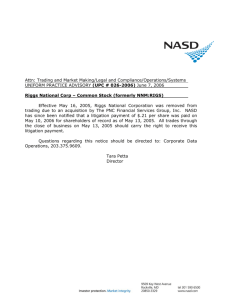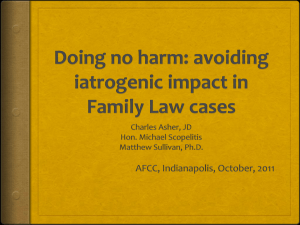Social Media’s Impact on the Fund Industry Christine Watts Johnston, Esq.
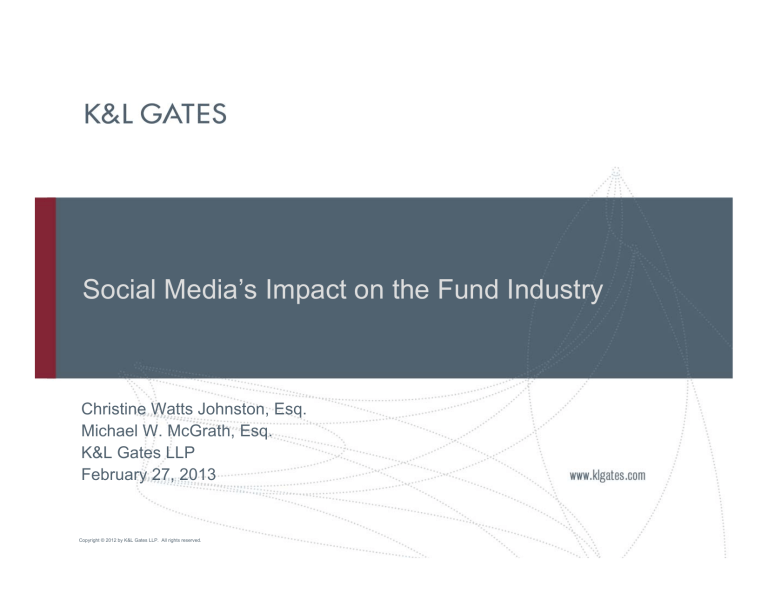
Social Media’s Impact on the Fund Industry
Christine Watts Johnston, Esq.
Michael W. McGrath, Esq.
K&L Gates LLP
February 27, 2013
Copyright © 2012 by K&L Gates LLP. All rights reserved.
Social Media’s Impact on the Fund Industry
What is Social Media?
Legal Framework and Regulatory Guidance
Social Media in the Workplace
Social Media Policies: Best Practices and Practical
Guidance
2
What is Social Media?
3
4
SEC National Exam Risk Alert:
“Social media is an umbrella term that encompasses various activities that integrate technology, social interaction and content creation. Social media may use many technologies, including, but not limited to, blogs, microblogs, wikis, photos and video sharing, podcasts, social networking and virtual worlds.”
“Social media is landscape-shifting. It converts the traditional twoparty, adviser-to-client communication into an interactive, multiparty dialogue among advisers, clients, and prospects, within an open architecture accessible to third-party observers. It also converts a static medium, such as a website, where viewers passively receive content, into a medium where users actively create content.”
Source: National Examination Risk Alert, January 4, 2012, SEC Office of Compliance Inspections and Examinations
5
Common Uses of Social Media:
General marketing
Expanding brand awareness
Promoting a firm’s website
Building customer loyalty
Connecting and educating clients and potential clients
Servicing clients
Customer and market research
Employment advertisements
Recruitment and Hiring
Community outreach
Litigation
Internal communications
6
Social Media commonly used in the financial services industry
7
Legal Framework and
Regulatory Guidance
8
Legal Framework and Regulatory Guidance
Statutory Provisions Impacting Social Media Use:
Anti-Fraud Provisions :
Section 206 of the Investment Advisers Act
Section 17(a) of the Securities Act
Section 10(b) and Rule 10b-5 under the Exchange Act
Section 34(b) of the Investment Company Act
FINRA Rule 2210
Advertising Rules :
Rule 206(4)-1 under the Investment Advisers Act
FINRA Rule 2210
’33 Act Rules 482 and 156
Rule 34b-1 under the Investment Company Act
9
Continued…
Legal Framework and Regulatory Guidance
Compliance/Supervision Rules :
Rule 206(4)-7 under the Investment Advisers Act
Rule 38a-1 under the Investment Company Act
NASD Rule 3010
Recordkeeping Rules :
Rule 204-2 under the Investment Advisers Act
’34 Act Rules 17a-3 and 17a-4
NASD Rules 2211, 3010
FINRA Rules 2210, 4511
Section 31 and Rule 31a-2 under the Investment Company Act
Suitability :
NASD Rule 2111
Private Offerings :
Reg D 502(c)
10
Advisers Act Rule 206(4)-1 -- Advertisements
Any written communication addressed to more than one person which offers any analysis, report or publication regarding securities, any device for making securities decisions, or any other investment advisory services regarding securities
May include emails, websites or social media posts
Prohibition on using advertisements that contain “untrue statements of material fact” or are “otherwise misleading”
Specific prohibitions:
Testimonials
Past specific recommendations
Graphs, charts and formulas
Free reports and services
11
SEC Guidance - OCIE National Examination Risk
Alert, Investment Adviser Use of Social Media,
January 2012
Social media is subject to the advertising rules, including recordkeeping and production requirements
Firms should identify risk exposure given their operations
Firms should test whether their compliance policies and procedures effectively address risks
Firms may be responsible for third-party content
12
Continued…
National Examination Risk Alert
Factors in Evaluating Effectiveness of Policies and
Procedures:
Usage guidelines
Content standards
Monitoring
Frequency of monitoring
Pre-approval of content
Firm resources
Criteria for approving participation
Training
Certification
Functionality
Personal/Professional sites
Information security
Enterprise-wide sites
Third-party postings
13
Continued…
National Examination Risk Alert
Rule 204-2 and Recordkeeping:
Records relating to a firm’s “advisory business” must be kept
If records are kept in electronic format, must be arranged and indexed to promote easy access
Conduct employee training regarding required records and periodically test to make sure employees are not destroying required records
Consider use of third-party vendors to keep records
14
Regulatory Considerations – FINRA Guidance
FINRA Regulatory Notice 10-06
Communication via the Internet, including social networks, is treated the same as in-person or written communication
Static postings on publicly available web sites are considered advertisements
Participation in forums such as chat rooms, online seminars, and other such interactive electronic forums is considered a public appearance
(as defined in NASD Rule 2210, now FINRA Rule 2210)
15
Regulatory Considerations – FINRA Guidance
FINRA Regulatory Notice 11-39
Responds to industry questions from Notice 10-06 by providing clarification concerning application of the rules to new technologies.
Recordkeeping
Supervision
Links to Third Party Sites
Data Feeds
16
Other Regulatory Considerations
State Guidance
Massachusetts Secretary of State Guidance on the Use of Social Media by Investment Advisers
Private Offerings
No general solicitation or advertising
Impact of the JOBS Act
CFTC / NFA Considerations
CTA exemption 4m(1)
CPO exemption 4.13(a)(3)
NFA advertising guidelines
17
Legal Framework and
Regulatory Guidance –
Third-Party Posts and Content
18
Testimonials
Includes an explicit or implicit statement of a client’s experience with, or endorsement of, an investment adviser
“Likes” and LinkedIn recommendations could be prohibited testimonials
Poorly received by the industry—Facebook “likes”
…but a careful reading of the SEC Alert reveals a “factsand-circumstances” test
19
Adoption and Entanglement Theories
Entanglement – the firm was involved in the content’s creation or preparation
A firm pays for an industry study
Soliciting a recommendation on LinkedIn
Linking to an affiliate’s content
Adoption – generally, an adviser has explicitly or implicitly through its actions adopted or endorsed content after it was created
Selectively removing content, such as unfavorable material
“Retweet” blog content
Facebook “likes”
20
Continued…
Adoption and Entanglement Theories
Links to third-party sites
SEC and FINRA have used adoption and entanglement theories in the context of a firm’s responsibility for thirdparty information that is hyperlinked to its website
Firms cannot know or have reason to know that the linked website contains false or misleading information
Disclaimers are useful for websites, but may not be available in certain Social Media
Recordkeeping requirements may apply to third-party Social
Media content
21
Disclaimers
Firm is not affiliated with [insert name of third-party social media site]
- use at your own risk
Firm is not responsible for and does not endorse any content, advertising, advice, opinions, recommendations or other information from third parties, including [the social media site]
Opinions, comments expressed by [friends or followers] are those of the persons submitting them and do not represent the views of the firm or its management
Firm does not endorse or approve content submitted by third parties, or endorse individuals or organizations, by using any features on this site
Firm reserves the right to block or remove any third-party content deemed illegal, inappropriate or offensive
Firm may block any posts that are testimonials, advice, recommendations, or advertisements for specific products or services
22
Social Media in the Workplace
23
Social Media in the Workplace
Is it legal to use social media in recruiting and hiring?
What steps can a firm take to protect its IP from disclosure or loss through social media?
Why does my non-unionized firm need to be concerned with the NLRB when it comes to social media?
How is social media impacting employment litigation?
24
Use of Social Media in Recruiting and Hiring: Is it legal?
25
Is it legal?
Benefits:
Access to information not otherwise available
Little to no cost to employers
Risks:
Control of process
Use of information
Transfer of information
26
Lawful Uses of Social Media information
Discover unprotected characteristics/activities
Illegal drug use
Support of racist/discriminatory groups
General poor judgment in maintenance of online persona
Assess cultural “fit”
27
Potential New Hires?
28
Privacy Implications
Requiring Access—pending legislation
Use of Information
Discrimination/too much information
Invasion of privacy
Defamation
Data privacy – strict international data transfer regulations
Searching
Website Terms of Use
Fair Credit Reporting Act
29
EEOC and Discrimination Considerations
Discrimination in the form of Disparate Treatment can occur if decision-makers check social media sites for only certain individuals and/or use information from these sites in different ways for different applicants or employees
If an employer relies heavily on social media information for employment decisions, they may have a Disparate Impact issue
Members of a particular race, gender or age group may be more likely to use social media
Older individuals or those with disabilities may be less likely to use social media
30
Terms of Use
Terms of Use may include restrictions on how information found on a site may be used.
Facebook “ You will not … take any action on Facebook that infringes or violates someone else's rights or otherwise violates the law.”
Westlaw Employers may use this site to perform people searches or search a person’s involvement in judicial proceedings.
Westlaw’s terms of use explicitly preclude use of information found in its database for employment screening.
31
Continued…
Terms of Use
By clicking “accept” on an Internet site’s terms—or even by merely using a site—an employer likely agrees to a contract governed by the laws of the state specified, often California.
Employer may even be subject to being sued in a foreign state.
Google “By using our Services, you are agreeing to these terms…All claims arising out of or relating to these terms or the Services will be litigated exclusively in the federal or state courts of Santa Clara County,
California, USA, and you and Google consent to personal jurisdiction in those courts.”
32
Does Third Party Searching
Insulate a Company from
Liability?
33
Fair Credit Reporting Act
Covers much more than just credit reports!
Any use of third party service to screen applicants may be implicated.
Examples:
34
Continued…
Fair Credit Reporting Act
May 2011 – FTC’s Division of Privacy sent
“no action” letter to Social Intelligence
Corporation
FTC – FCRA rules apply in social networking context
State law
35
Fair Credit Reporting Act Requirements
Employer must notify applicant/employee that consumer report will be used, and applicant/employee must consent.
If employer relies on consumer report as basis for
“adverse action,” employer must:
Give applicant/employee copy of report and notice of rights created by FTC before adverse action; and
Provide notice of adverse action and required information to follow up
36
What Steps Can a Company
Take to Protect Its
Proprietary Information from
Disclosure through Social
Media?
37
Personal Is Public
Just heard CalPERS is very pleased with #AcmeAM and will contribute more assets next qtr!
Did your employee just publish a client testimonial?
So cool, I’m moving to London! My firm is opening a new office!
Did your employee reveal expansion plans that are not yet public?
38
Social Media Account and Content Ownership
Ownership of twitter followers – Phone Dog case
Ownership of Linked-In account following acquisition— Eagle case
Trade secret protection
39
Social Media Ownership Issues
Who owns social media posts and profiles?
What happens when an employee leaves?
Protocol for Broker Recruiting
Can an employee publicly share his or her departure?
40
Practical Steps to Take
Develop and implement NDA with any parties with whom the firm shares its confidential information and label items
“Confidential”
Adopt appropriate firewall and password-protected measures for digitally stored and shared documents
Enter into agreement with employees addressing social media content and account ownership
Act promptly at the end of an employment relationship
41
Social Media – Securities Implications
Example: Blogs
FTC investigation of Whole Foods Market’s CEO’s online postings
SEC concern regarding violation of Reg FD
42
Social Media – Securities Implications
Netflix CEO posts a message regarding viewership growth on
Netflix stock rises 20% in 3 days
Netflix receives a Wells Notice
Is Reg FD out of date?
Netflix had over 200,000 followers, including many reporters
43
Why Does My Non-
Unionized Firm Need to be
Concerned with the NLRB
When It Comes to Social
Media?
44
Increased Authority of NLRB
Section 7 of NLRA applies to all employers
Provides employees with right to “…engage in other concerted activities for purpose of collective bargaining or other mutual aid or protection”
NLRB now bringing ULP charges against employers – union and non-union – who discharge or discipline employees for posting comments on Facebook about working conditions
NLRB scrutinizing social media policies for ALL employers (even non-unionized) and finding unlawful interference with concerted activity
45
NLRB Concern: Chilling Exercise of §7 Rights
“unauthorized posting, distribution, removal or alteration of any material on
Company property”
Prohibition against discussing private matters of other employees
Prohibition against sharing, transmitting or storing “sensitive information”
Prohibition against sharing “confidential” information such as employees’ names, addresses, phone numbers and emails
Statements that damage company or any person’s reputation
Costco Wholesale Corp.
, 358 NLRB 106 (2012)
46
Social Media in Litigation
47
Social Media in Employment Litigation
Retention policies – ESI
Spoliation
Acceptable breadth of discovery
litigation strategy
Privacy rights
Ethical considerations
48
Social Media in Litigation – Facebook Example
Targonski v. City of Oak Ridge
49
Continued…
Social Media in Litigation – Facebook Example
Targonski v. City of Oak Ridge
50
Continued…
Social Media in Litigation – Facebook Example
Targonski v. City of Oak Ridge
51
Social Media Policies: Best
Practices and Practical Guidance
52
Social Media Policies – The Big Picture
The potential benefits from using social media increase as employees are allowed greater freedom to interact with the public
So do the risks
A firm should determine its risk tolerance for using
Social Media before implementing policies
53
Continued…
Social Media Policies – The Big Picture
What type of Social Media firm are you?
1.
Absolute prohibition
2.
Prohibition on content re: firm’s business activities
3.
Business content through “official” channels only
4.
Co-opt personal posts through standards or review
5.
Absolute freedom
Absolute prohibition and absolute freedom are impracticable for financial services firms
The success of the other strategies will depend on risk control through thoughtfully designed and implemented policies
54
Social Media Use by Investment Advisers
80% of firms have adopted formal written policies and procedures to govern the use of social networking by the firm and/or employees, up from 64% last year
54% of firms test compliance with social media policies;
24% quarterly, 47% annually or semi-annually
Annual testing is most common (31% of firms), but 24% of firms test social media policies quarterly
54% of firms prohibit using personal social networking sites for business purposes
Source: Investment Adviser Association 2012 Investment Management Compliance Testing Survey
55
Developing and Administering
Social Media Policies
56
The Need for Policies and Procedures
Under the Advisers Act, no failure to supervise if:
Procedures reasonably be expected to prevent violations
Duties reasonably discharged
Rule 206(4)-7:
Written policies and procedures reasonably designed to prevent violation of the Advisers Act
Is it reasonable to not have a Social Media policy after the SEC
National Exam Risk Alert?
NASD Rule 3010:
Written supervisory procedures regarding firm business, and the activities of associated persons
Reduce business risks associated with recruiting, hiring, retention, and litigation
57
Risk Assessment
Identify business purposes, identify risks, and draft procedures around this risk assessment
Coordinate legal/compliance, IT, HR, and privacy departments on enterprise-wide basis to ensure policy addresses applicable laws
Address separate business and personal accounts
Define “Social Media” and state the firm’s philosophy
Tailor your policy to the specific risks of your organization
58
Draft a Social Media Policy
Establish a formal policy before providing any guidance to employees regarding use of Social Media
Specifically identify:
Permitted or prohibited sites
Permitted or prohibited features of those sites
Who can represent the firm
Who maintains passwords
Address use on personal devices
Establish a standard and a process for compliance review
Consider addressing inappropriate personal uses of social media ( e.g
., defamatory or illegal content, disparagement of competitors, company logo or endorsements)
59
Implement a Social Media Policy
Social media training
Social Media changes quickly—plan frequent, smaller training modules
Use training to learn from employees—they will think of usage you did not know was possible
Establish a social media review team—consider business, compliance, legal
Monitor social media sites frequently and efficiently
pre- or post- review by compliance (or both)
60
Continued…
Implement a Social Media Policy
Monitor employees, follow-up on “red flags,” and take disciplinary actions for violations
Consider a vendor for monitoring, site-blocking, and recordkeeping (See Appendix)
Monitor changes to features/settings on permitted sites and modify policy as appropriate
Test procedures – are the effective, do they address changing or new technologies?
Incorporate social media into your ongoing risk assessment and annual review process
61
Commenting Guidelines For Firm-Hosted Content
No personal information or information about an individual’s accounts
No testimonials about how well a client has done by investing with the firm
No investment advice or recommendations about specific stocks or funds
No attacks on the firm or fellow viewers
No offensive or defamatory comments
No illegal information, such as material, non-public information
(insider trading)
No customer-service related questions
Read [insert name of third-party social media site’s] terms of service and privacy policy, as they apply to communications through the page/account
62
Guidelines for Personal Activity
Identification as an employee of the firm
Referral of clients, customers, partners—business activities may entangle the firm
Investment recommendations and discussion of past recommendations should be prohibited
Address confidentiality of firm data
Consider standards for interactions with other personnel of the firm
63
Guidelines for Third-Party Content
Consider disabling or blocking third-party posts on the firm's Social Media pages
Use disclaimers, if available
Compliance should review links and "re-tweets"
Be careful managing content—it may be misleading to delete negative third party content, leaving only positive remarks
64
Best Practices for Using Social Media in
Recruiting, Hiring and Employment
If you are recruiting through Social Media, adopt formal, consistent procedures and require uniform use
Have non-decisionmakers do the searching and report only job-related information
Comply with Terms of Use of relevant sites and avoid improper search tactics
Provide ongoing employee education and training
Update authorizations/releases for background checks
Supplement internet searches with other assessments, i.e. reference checks, second interviews
65
Continued…
Best Practices for Using Social Media in
Recruiting, Hiring and Employment
Update Social Media policies regularly
Consider whether any aspect of a social media search could be considered discriminatory
Make sure there is a legitimate nondiscriminatory basis for employment decisions
Be aware of NLRB rules concerning social media
Firm’s corporate conduct code is always applicable
66
Recordkeeping – Regulatory Considerations
The SEC views all electronic communications as written communications
Advertisements and client communications via Social Media are subject to rules applicable to funds, adviser, and broker-dealers
If you can’t keep appropriate records of an activity, it should be prohibited
Consider third-party record capturing software
Iron Mountain
Microsoft
Others (See Appendix)
Establish a process for determining which Social Media communications are required records
67
Recordkeeping—Additional Considerations
E-discovery rules apply equally to social media
FRCP 16, 26, 33, 34, 37, 45
Retention requirements: personnel files, FLSA, ERISA,
ADEA, ADA, USERRA
Rules of Evidence
Business record exception to hearsay rules (FRE 803 (b)(6))
FRE 502
FRE 901
68
Other Policies to Update
Anti-harassment / discrimination / retaliation policy
Discipline / termination policy
Confidential information / trade secret policy
Cellphone / driving policy
Working hours policy
Open door policy
Acceptable usage policy
Workplace privacy
69
Industry Specific Best Practices
Emphasize to employees the importance of good judgment
Put someone in charge of compliance and ESI policies
Clearly define employees’ use of social media
Keep good records and expect them to be discoverable
Take advantage of existing compliance technology
70
Appendix – Resources
71
Resources – Monitoring Software Vendors
Google www.google.com/alerts
Infegy http://infegy.com/
BrandProtect www.Brandprotect.com
Nielsen www.Nielsen-online.com
(BuzzMetrics)
Radian6 www.Radian6.com
Sysomos www.sysomos.com
Visible www.visibletechnologies.com
Spredfast www.spredfast.com
Viralheat www.viralheat.com
72
Resources – Capture Software Vendors
LiveOffice www.liveoffice.com
Socialware www.socialware.com
Erado www.erado.com
Flowtown (for ROI research) www.flowtown.com
73
Our Panelists
Mr. McGrath practices in the area of investment management and securities law, and focuses on advising investment advisers, broker-dealers, commodity trading advisers, and commodity pool operators in connection with the legal and regulatory aspects of their global operations. He also advises clients with respect to the structuring and offering of mutual funds, hedge funds, and private equity funds.
Mr. McGrath has extensive experience counseling investment advisers regarding their regulatory compliance obligations, and in connection with SEC staff examinations. He also has experience drafting and negotiating derivatives instruments on behalf of investment managers. Mr. McGrath is a CFA charterholder, and has held Series 7, 24, and 66 licenses over his career.
Michael W. McGrath
Counsel
Tel: 617.951.9123
michael.mcgrath@klgates.com
Christine W. Johnston
Partner
Tel: 617.261.3138
christine.johnston@klgates.com
Ms. Johnston concentrates her practice in the employment and labor area where she represents employers in a wide range of matters. Ms. Johnston has significant experience representing employers in contract disputes, noncompetition and misappropriation of trade secret cases, discrimination, harassment and retaliation cases, wage and hour disputes, employee misconduct matters, and tort-based claims. Ms. Johnston also advises and counsels employers regarding employee relations, employment practices and procedures and compliance with state and federal employment and labor laws and regulations.
Ms. Johnston advises companies on social media policies and related issues. She also has experience advising companies and litigating disputes related to data privacy breaches and compliance with data privacy regulations. Ms. Johnston frequently collaborates with employee benefits specialists to address executive compensation and employee benefits matters. She regularly assists with due diligence, disclosures, employment and restrictive covenant agreements and other employment matters in business transactions.
74
Social Media’s Impact on the Fund Industry
Christine Watts Johnston, Esq.
Michael W. McGrath, Esq.
K&L Gates LLP
February 27, 2012
Copyright © 2012 by K&L Gates LLP. All rights reserved.
